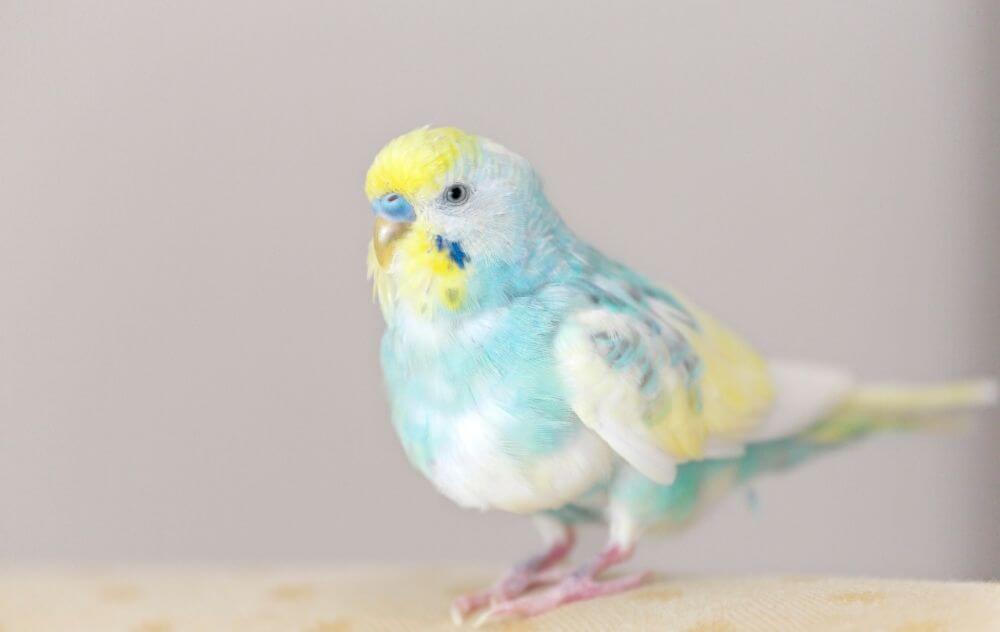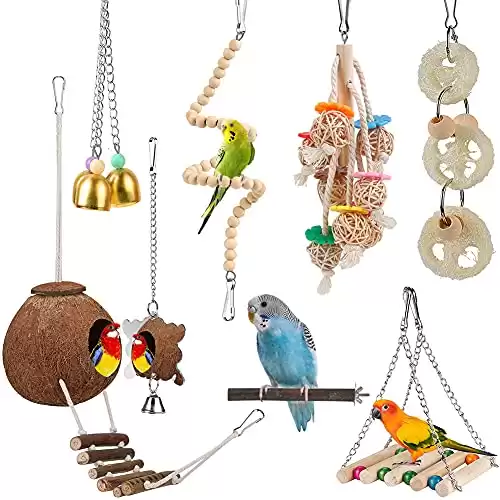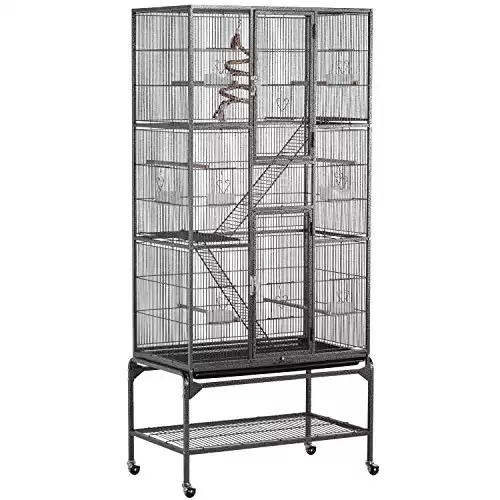Budgies are clever and communicative little birds, but sometimes it can be difficult for humans to read their signals accurately.
One of the more subtle ways they show people and other birds how they feel is by using their feathers, which can be flat against their bodies or fluffed up for a more puffy look.
So if you’re wondering, “Why is my budgie puffed up?” there are a few signs to look for to help you determine the answer.
Why Do Budgies Puff Their Feathers?
There can be a wide range of reasons why budgies puff up. Some are good, and some can be a sign that something is wrong.
The top reasons your budgie may be puffed up include:
- Getting ready to sleep
- Happiness and excitement
- Feeling scared or upset
- Feeling cold
- Grooming and preparing for a bath
- Illness or discomfort
With such a wide range of reasons behind this common behavior, it’s important to look at other behaviors to help you figure out exactly what is going on with your feathered friend.

6 Reasons Why Your Budgie is Puffed Up
Getting Ready for Bed
One of the most common times you’ll see your budgie puff up is later in the evening when your bird is settling in for a good night’s sleep.
Wild budgies often have to deal with colder temperatures overnight, so they tend to puff up their feathers to provide better insulation and stay warm as they sleep.
While your pet budgie may not have the same problem with cold nighttime air indoors, you may still notice your bird puffing up at bedtime.
It’s an instinctive behavior and a sign that your budgie is relaxed and feeling cozy.
Happiness and Excitement
This one can be a little more variable, but some particularly expressive birds like to puff up their feathers when they’re excited about something.
It’s often obvious when your budgie is puffed up for this reason because it may be accompanied by head bobbing and other happy movements.
It’s often related to introducing a fun new thing, too, such as a new treat or toy. Budgies also sometimes do this when they’re around other birds as a way to show off and get the other bird to engage.
Sometimes budgies will also simply puff up when they’re calm and content. In this situation, it’s usually primarily the chest feathers that are puffed out.
The bird also may tuck up one of its feet and close its eyes to fully relax.
Feeling Scared or Upset
On the other end of the spectrum, budgies may puff up their feathers when they feel alarmed or threatened to make themselves look bigger.
You can usually tell the difference between fearful fluff and happy fluff through the rest of the bird’s body language.
A scared bird will generally hold its wings out some distance from its body, and it may hold its tail feathers out or twist them in an odd way. Your bird’s body language will seem tense and anxious, and it may resist any attempts to touch or hold it.
Some birds may act very agitated or aggressive, while others may remain unusually still.
Feeling Cold
Budgies tend to do best in warmer temperatures, with the ideal climate being about 70 to 75 degrees Fahrenheit.
However, if the temperatures start dropping too low, they will puff up their feathers to help trap warm air next to their bodies, which provides more insulation and helps them regulate their body temperature better.
Most budgies can handle short, occasional cold spells just fine, so there’s no reason to worry if your bird occasionally puffs up when you forgot to turn the heater on for a little while.
However, if your house is fairly chilly and you notice your budgie is frequently puffed up for no apparent reason, you may want to turn the thermostat up a little bit or invest in a suitable heat source for your bird’s habitat.
It’s also a good idea to ensure it doesn’t stay too cold for too long.
Budgies can generally regulate their body temperature well for a few hours, but if they spend more than six hours in chilly temperatures, they experience a higher risk of hypothermia.
Temperatures below freezing are also dangerous for these warm-weather birds, even for fairly short periods.
Grooming and Preparing for a Bath
Some budgies can be very meticulous little birds. These budgies often enjoy bathing every couple of weeks in fresh water and may frequently groom themselves. If your bird enjoys a good spa day from time to time, you may notice it puffing up its feathers before it begins to bathe.
This allows the bird to shake out some built-up dirt, air out its skin, and clean itself more thoroughly. It can also simply help smooth and straighten the feathers out if they get ruffled up uncomfortably.
However, if your budgie bathes less frequently or not at all, don’t worry. It doesn’t mean that your bird is unhealthy, just that it doesn’t feel the need to groom as often. As long as its feathers look healthy, your bird is probably fine.
Illness and Discomfort
This is the reason that every budgie owner fears. Sometimes budgies puff up because they’re sick or injured. The easiest way to tell the difference between this and other harmless types of puffing is that a sick budgie will typically remain puffed up for most or all of the day.
You can also try approaching the bird as if you’re going to pick it up. A healthy budgie will typically slick its feathers down in anticipation of being handled, but a sick one will often remain puffed up.
Illness is typically also accompanied by other symptoms. These often include:
- Low energy and lethargy
- Refusing to eat even favorite foods
- Sitting with eyes half-closed or fully closed despite not being asleep
- Slumped or unusual posture
- Labored breathing, including tail bobbing with each breath
- Discharge from the nose, mouth, or eyes
- Changes to the bird’s poop, such as undigested food or sticking to vent feathers
- Weight loss
- Ragged or dirty feathers combined with a lack of preening
- Crusting on the nose or feet
- Excessive plucking of feathers
In addition, if you know your bird well and notice a sudden change of behavior for no apparent reason, it could be a warning sign of an illness.
It may just be a reaction to a subtle change in the environment or a normal development as your bird changes and grows, but major changes are something to keep an eye on in case additional symptoms start to show.
What To Do When Your Budgie Is Puffed Up
Most of the time, you don’t have to do anything when your budgie has its feathers puffed. It’s completely normal and often adorable behavior that usually means your bird is happy and healthy. At most, you may need to switch on your bird’s cage heater if your house is chilly.
However, if you believe your bird is sick, it’s vital to act as promptly as possible. Contact a veterinarian immediately, preferably one that specializes in birds or exotic pets.
Budgies can be fragile at times and may become very sick in a brief time, so it’s crucial to take action immediately.
As you wait to reach a veterinarian, keeping your budgie warm is essential. Heat lamps, cage heaters, or heating pads are all good options to help your sick budgie stay cozy.
However, this is not a substitute for veterinary care. It’s also important not to overdo it.
Remember, budgies do best when their surroundings are around 70 to 75 degrees, so try not to exceed that.
It’s important to remember that budgies often don’t show any signs of illness until they are very sick, so it’s best to contact your veterinarian whenever you think there may be something wrong.
Even if the symptoms are mild, your veterinarian can talk you through the details and advise you on whether you need to bring the bird in for a physical exam or not. When in doubt, always call your vet first.
Even though birds and humans communicate in very different ways, an attentive owner can learn what’s normal and what isn’t for each individual bird.
With a bit of time and research, you can eventually start to understand why your budgie is puffed up and what, if anything, you need to do to help your feathered friend be more comfortable.
More to read:

My name is Niels Joensen, and I’m the creator of Wings and Beaks. I got my first two budgies at the age of 13, and right away, I fell in love with these beautiful tiny birds. Wings and Beaks is where I share my knowledge and passion for budgies with other bird owners.



